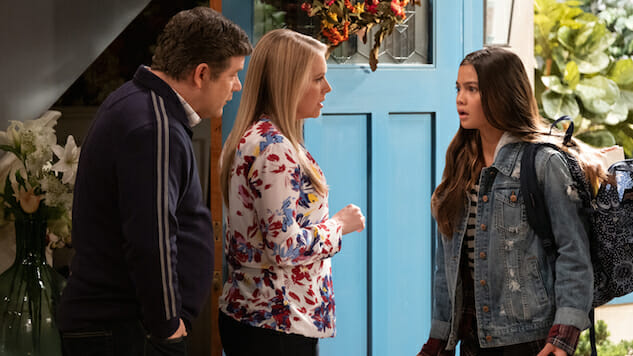Netflix’s No Good Nick Is the Most Confounding Sitcom We’ve Ever Seen
Photo: Netflix
Since the moment the first press release for Netflix’s newest multicam sitcom, No Good Nick, appeared in my inbox, I’ve been trying—and failing—to imagine what its pitch meeting must have been like:
“So it’s about this thirteen-year-old foster kid, Nick, right? Who moves in with a family parented by Gen X darlings Melissa Joan Hart and Sean Astin, OK? Only, get this, she’s actually a tiny con artist, there at the double-con behest of petty thief foster parents and her mysteriously jailed manipulator of a dad to bilk ol’ Sabrina and Samwise out of their upper- middle-class comfort.”
“So, it’s a multicam sitcom that’s… serialized?”
“Obviously.”
“And half the adults in this kid’s life are set to take severe advantage of her?”
“This girl will need serious counseling by the time we’re through with her.”
“And… there’s a laugh track?”
“Oh, absolutely there’s a laugh track.”
“Sold.”
If this sounds like I’m about to come down hard on No Good Nick, I’m not. All 10 episodes from Part 1 were provided to critics, and I genuinely enjoyed watching it. In fact, from the moment I settled in, I found it nearly impossible to put my phone down. (Don’t @ me; No Good Nick is not a show that suffers for being consumed on a handheld screen. And, for the record, the series includes both a laugh track and scenes filmed before a live studio audience, according to Netflix.) Barring a few major outliers—How I Met Your Mother chief among them—the multicam sitcom is not a natural home for high-concept serialization, but between the format’s familiar beats, the solid sitcom chops of the Hart/Astin-led ensemble cast, and the propulsiveness of Nick’s long con—so deeply serialized that most episodes pick up in the same breath the previous one left off—No Good Nick handily comes together as a ripping low-stakes binge.
-

-

-

-

-

-

-

-

-

-

-

-

-

-

-

-

-

-

-

-

-

-

-

-

-

-

-

-

-

-

-

-

-

-

-

-

-

-

-

-








































